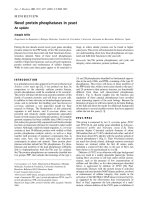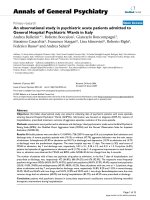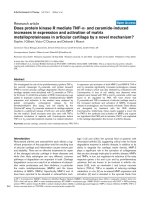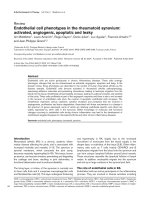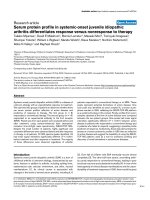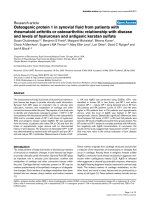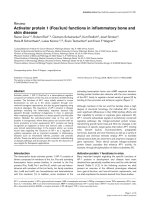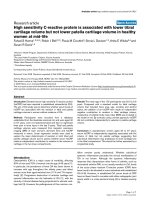Báo cáo y học: "Activated protein C in severe acute pancreatitis without sepsis" pptx
Bạn đang xem bản rút gọn của tài liệu. Xem và tải ngay bản đầy đủ của tài liệu tại đây (118.19 KB, 2 trang )
In the present issue of Critical Care, Pettila and colleagues
report the fi rst single-centred pilot randomized
controlled trial of activated protein C (APC) in alcohol-
induced acute pancreatitis of moderate severity but
without infection [1]. After screening 215 patients, 32
patients satisfi ed the trial inclusion criteria and were
randomized to either placebo or APC at 24 μg/kg/hour
for 96 hours, in addition to standard therapy for acute
pancreatitis. e study – powered to evaluate the eff ect
of APC on the change in organ dysfunction, measured
using the Sequential Organ Failure Assessment score as
the primary outcome – failed to show any benefi t.
In acute pancreatitis, severity is defi ned by the occur-
rence of organ failure and/or peri-pancreatic complica-
tions. Severe acute pancreatitis (SAP) is characterized by
the presence of an overwhelming infl ammatory response,
with unregulated activation of the coagulation system.
Evaluation of the coagulation and the endogenous
protein C/antithrombin III (AT III) system shows that
nonsurvivors in SAP have signifi cantly lower levels of
protein C and AT III activity, and higher levels of
D-dimer and plasminogen activator inhibitor-1, than sur-
vivors [2]. ese changes mirror the patterns seen in
severe bacterial sepsis that suggest exhaustion of fi brino-
lysis and coagulation inhibitors, thereby identifying a
possible role for APC in SAP independent of the need to
diagnose severe sepsis. Prior to the study by Pettila and
colleagues [1], the literature was limited to animal studies
[3,4] and to subgroup data from the PROWESS trial of 62
patients with acute pancreatitis and severe sepsis, where
there was a trend to reduced mortality in those treated
with APC (24% vs. 15%) [5]. e Consensus Guidelines
thus recom mended that careful consideration is given to
APC therapy in those patients with SAP and infection,
given the theoretical but unproven concern of
retroperitoneal haemorrhage [5].
SAP is a devastating disease with an attributable mor-
tality of around 30%, and thus interventional trials are
required to fi nd a potential therapy to improve outcome.
Although commendable, this pilot trial of APC in
pancreatitis must be interpreted with caution. As the
authors point out, the study is underpowered to detect
any meaningful diff erence in the primary outcome –
change in the Sequential Organ Failure Assessment score –
as a surrogate for APC eff ect. e authors also report no
diff erence in bleeding complications, yet serious bleeding
is actually a relatively infrequent event in patients treated
with APC. In a meta-analysis of 10,679 APC-treated
patients, the incidence of serious bleeding was 3.3% [6].
is equates to approximately one serious bleeding event
per 30 patients; consequently, in a study involving only 16
APC-treated patients it is diffi cult to draw any clinically
relevant conclusions (good or bad) with respect to bleeding.
e mortality benefi t with APC is best shown in
patients with severe sepsis and high risk of death; for
example, patients with multiple organ dysfunction, patients
with Acute Physiology and Chronic Health Evaluation
(APACHE) II score ≥25, or those in shock [7]. ere has
Abstract
Severe acute pancreatitis (SAP) is characterized by
an unregulated systemic proin ammatory response
secondary to activation of trypsin within the
pancreatic tissue, resulting in multiple organ failure.
This dysregulated in ammation leading to organ
dysfunction also characterizes severe sepsis. Activated
protein C (APC) has pleotropic e ects on the immune,
coagulation, in ammatory and apoptotic pathways,
and has been postulated to bene t acute pancreatitis–
although concerns of possible retroperitoneal bleeding
remain. Currently, experimental studies and subgroup
data on patients with pancreatitis from a randomized
controlled trial of APC in severe sepsis form the
literature on the possible role of APC in SAP. We review
the rst randomized controlled trial of APC in acute
pancreatitis published in the present issue of Critical
Care.
© 2010 BioMed Central Ltd
Activated protein C in severe acute pancreatitis
without sepsis? Not just yet …
Manu Shankar-Hari and Duncan Wyncoll*
See related research by Pettila et al., />COMMENTARY
*Correspondence:
Guy’s and St Thomas’ NHS Foundation Trust, London SE1 7EH, UK
Shankar-Hari and Wyncoll Critical Care 2010, 14:188
/>© 2010 BioMed Central Ltd
always been debate regarding benefi t in the patients at
low risk of death, such as those in the lowest quartile of
the PROWESS trial (that is, APACHE II score <17). e
severity of illness and risk of death due to acute
pancreatitis in this pilot trial was low (mean age of 47,
mean APACHE II score of 14 and zero mortality in the
control arm). Moreover, 34% of the patients never
required invasive ventilation and 37% never developed
shock requiring a vasopressor. e population studied is
thus likely to be confounding the results. Indeed, for
subsequent trials with APC the inclusion criteria have all
focused on ensuring high severity of illness, including the
important ongoing PROWESS-SHOCK trial [8,9].
Identifying individual patients who are likely to benefi t
the most and to suff er the least morbidity from an
intervention is a challenge, and there is an increasing role
for biomarkers to assist in this endeavour. In the context
of APC, serial measurements of protein C may be the
best biomarker in establishing those most at risk of poor
outcome in severe sepsis, may highlight those patients
most likely to benefi t from APC, and also may prove
useful in monitoring therapy [10]. As protein C defi ciency
has been demonstrated in experimental early SAP, this
trial might have been more relevant had it measured
protein C as a biomarker. In addition, the observed low
mortality in the study highlights the importance in study
design of selecting a population who are genuinely at
high risk of death and are potential ideal candidates for
what is an expensive and debated therapy [2,11].
is pilot study is underpowered to contribute signifi -
cantly to the baseline data necessary to inform the design
of a future interventional trial assessing APC as a
potential therapy in SAP. If further trials with APC are
undertaken in this disease, it is essential they have the
scope and ability to capture a genuinely high-risk popu-
lation and provide the intervention in a timely manner.
Consideration should be given to selecting patients at
highest risk of progressive organ dysfunction defi ned by
at least moderate protein C defi ciency.
Abbreviations
APACHE, Acute Physiology and Chronic Health Evaluation; APC, activated
protein C; SAP, severe acute pancreatitis.
Competing interests
In the last 5 years DW has contributed to a number of trials of activated
protein C in severe sepsis which have been sponsored by Eli Lilly. He has also
received honoraria from Eli Lilly (the manufacturers of activated protein C) for
speaking at educational meetings.
Published: 9 August 2010
References
1. Pettila V, Kyhala L, Kylanpaa M-J, Leppaniemi A, Tallgran M, Markkola A,
Puolakkainen P, Repo, H, Kemppainen E: APCAP – activated protein C in
acute pancreatitis: a double-blind randomized human pilot trial. Crit Care
2010, 14:R139.
2. Radenkovic D, Bajec D, Karamarkovic A, Stefanovic B, Milic N, Ignjatovic S,
Gregoric P, Milicevic M: Disorders of hemostasis during the surgical
management of severe necrotizing pancreatitis. Pancreas 2004, 29:152-156.
3. Ping C, Youngping Z, Minmin Q, Weiyan Y, Yaozong Y: Activated protein C
improves severity of acute pancreatitis via up-regulating the expressions
of endothelial cell protein C receptor and thrombomodulin. Dig Dis Sci
2010, 55:1599-1609.
4. Alfasser G, Warshaw AL, Thayer SP, Antoniu B, Laposata M, Lewandrowski KB,
Fernandez-del Castillo C: Decreased in ammation and improved survival
with recombinant human activated protein C treatment in experimental
acute pancreatitis. Arch Surg 2006, 141:670-676.
5. Nathens AB, Curtis JR, Beale RJ, Cook DJ, Moreno RP, Romand J-A, Skerett SJ,
Stapleton RD, Ware LB, Waldmann CS: Management of the critically ill
patient with severe acute pancreatitis. Crit Care Med 2004, 32:2524-2536.
6. Khan A, Agarwal R, Aggarwal AN, Gupta D: Prevalence of serious bleeding
events and intracranial hemorrhage in patients receiving activated
protein C: a systematic review and meta-analysis. Respir Care 2010,
55:901-910.
7. Camporota L, Wyncoll DLA: Practical aspects of treatment with drotrecogin
alfa (activated). Crit Care 2007, 11:S7.
8. Levi M, Levy M, Williams MD, Douglas I, Artigas A, Antonelli M, Wyncoll D,
Janes J, Booth FV, Wang D, Sundin DP, Macias WL; Xigris and prophylactic
heparin Evaluation in Severe Sepsis (XPRESS) Study Group: Prophylactic
heparin in patients with severe sepsis treated with drotrecogin alfa
(activated). Am J Respir Crit Care Med 2007, 176:483-490.
9. Finfer S, Ranieri VM, Thompson BT, Barie PS, Dhainaut J-F, Douglas IS,
Gardlund B, Marshal JC, Rhodes A: Design, conduct, analysis and reporting
of a multi-national, placebo-controlled trial of activated protein C for
persistent septic shock. Intensive Care Med 2008, 34:1935-1947.
10. Shorr AF, Nelson DR, Wyncoll DLA, Reinhart K, Brunkhorst F, Vail GM, Janes J:
Protein C: a potential biomarker in severe sepsis an a possible tool for
monitoring treatment with drotrecogin alfa (activated). Crit Care 2008,
12:R45.
11. Ottesen LH, Bladbjerg EM, Osman M, Lausten SB, Jacobsen NO, Gran J, Jensen
SL: Protein C activation during the initial phase of experimental acute
pancreatitis in the rabbit. Dig Surg 1999, 16:486-495.
doi:10.1186/cc9190
Cite this article as: Shankar-Hari M, Wyncoll D: Activated protein C in severe
acute pancreatitis without sepsis? Not just yet … Critical Care 2010, 14:188.
Shankar-Hari and Wyncoll Critical Care 2010, 14:188
/>Page 2 of 2

